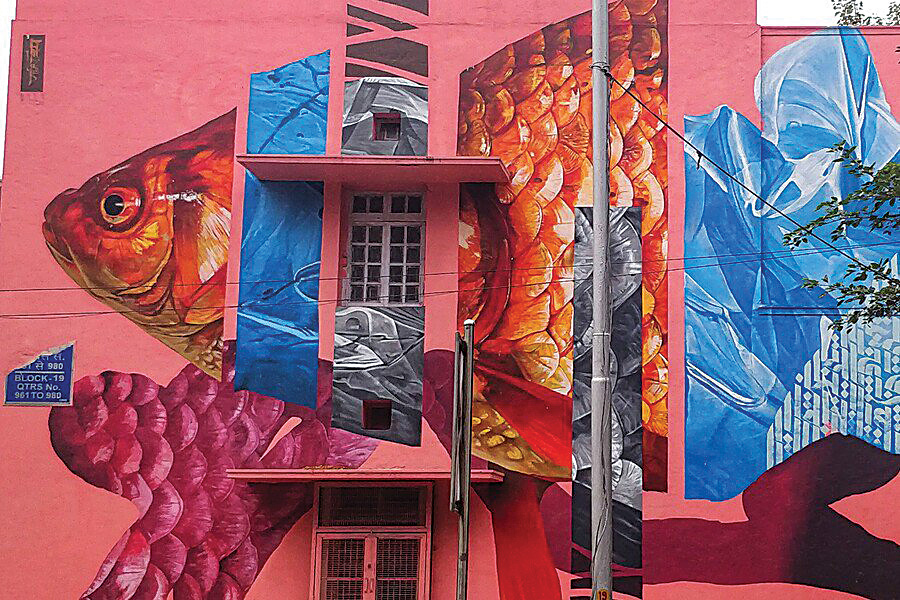SOMETIMES BEAUTIFUL, SOMETIMES DISTURBING, KIRAN MAHARJAN’S ART compels YOU to THINK
A crowd gathers. Admittedly, a fairly routine occurrence in Nepal, where people form energetic knots on the street at the slightest provocation. Except, this is a rather curious collection. At the centre of it all is Kiran Maharjan, contentedly and quickly covering the walls of Patan with theatrical colour.
In Nepal, where walls are liberally splashed with colour, obviously the context is quite different. Which is what makes Kiran’s project as challenging as it is intriguing. Inspired by local heroes like Laxmi Prasad Devkota who has contributed to the literature history of the country, he has conceptualised a visual dialogue between art and people to stimulate the enormous possibilities for the youth of Nepal in the country itself.
At the frontline of initiating an urban art show ‘Prasad Project’ in 2015, the project was an attempt to address the contemporary issues of youth migration caused by the decade long history of political turmoil through exhibitions, workshops and public mural. For phase two, the Director of the Institute, Helmut Schippert whose interest lies in integrating art into urban development, has been working with Chennai Connect to find suitable spaces to inject with colour; stark flyovers, old buildings, walls covered in peeling posters.
Visual and Street Artist, Kiran is a 2014 graduate from Kathmandu University and is also known as H11235. His work portrays realistic imagery with spray, paints and elements of calligraphy. The street artist’s painted murals revolve around the concepts of humanism and human nature. Kiran has previously exhibited his work at the Nepal Art Council and Siddharth Art Gallery. His work has also found its way to India and the US. If you visit the north wall at 755 Charnelton Street, Eugene, Oregon, a half portrait of an old man from Nepal painted by the artist can be seen.
Born and raised playing in the maze of lanes of Patan, he holds a strong connection with the streets of the valley – the vibrant jatras and festivals, traditional and cultural activities, protests and political revolution. The artist believes that the notion of the street is constantly changing but sooner or later it comes back to a space of interaction where people socialise with their neighbours and friends, and their locality and communities are built around the chowks.
When asked about the turning point in his career, Kiran recalls an invitation to an art project in Goa, India. “The exposure was such that it landed me on many international platforms.” In 2018, the opportunity to meet new people and several other artists led him to an urban art project called St+Art India, a collaborative platform for the best contemporary artists to create public art in India. For Kiran, the art project was the beginning of a long-term relationship with murals beyond the streets and walls of Nepal. Kiran recalls, “With the colourful city of Coimbatore in Tamil Nadu, I have a very special connection as it was a trip that deconstructed my traditional way of travelling and got me out of my comfort zone.”
“In the end, it wasn’t about what I made as an artist, but the homely environment and people surrounding me. We lived in the moment, laughed, played and worked, and I realised that the most beautiful things in life are people, places, and memories.” he shares.
The artist says that initially art was a second choice of career with the first being herpetology, the study of reptiles and amphibians. “My initial plan was to work closely with animals like snakes and crocodiles. To study and excel in the field required a huge investment that I could not afford. Hereby art was my alternative,” he reminisces. But sometimes the path destiny chooses is the best, and Kiran’s journey is a testimony to unplanned journeys.
Meanwile, Kiran found his personal signature with black and white calligraphy portraits. Over the past few years, Kiran has dug into the realms of human psychology and tries to give expression to his understanding through his art. In the process, he continues to discover himself.




